Content Warning: This op-ed discusses or references racism, white supremacy, antisemitism, and threats of violence and sexual assault. It also contains screenshots of emails that reference these themes.
On the morning of November 2, an automated email from the Office of Equal Opportunity Programs appeared in my UChicago inbox, nudging me to complete a training module on harassment prevention. As it happened, this email arrived sandwiched between 23 others urging me among other things to come to Jesus, go into hiding, and “delete myself.” I could appreciate the irony, but as the day unfolded the invective got uglier. A quick search revealed its origin: A UChicago undergraduate, whom I’ve never met, had apparently attacked my seminar on whiteness on Twitter the afternoon prior. In a lengthy thread, the student accused my course, which had just opened for registration in winter quarter, of exemplifying “anti-white hatred.” One tweet dissected a screenshot of my course description, as if it served as evidence of my bigotry, that he had “exposed.” Another offered over 30k followers a screenshot of my faculty page, including my university email and headshot. This is the face, the student implied, of institutionalized “anti-white” racism:

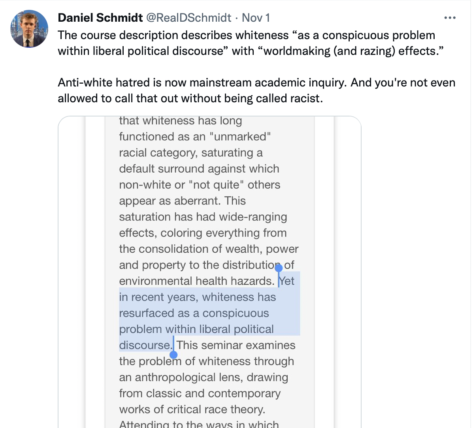
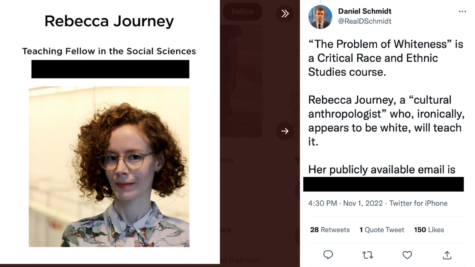
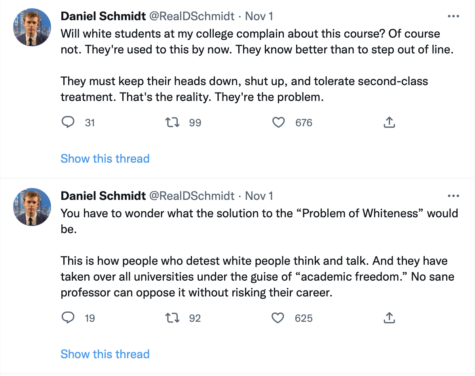
On November 5, he tweeted an UPDATE:
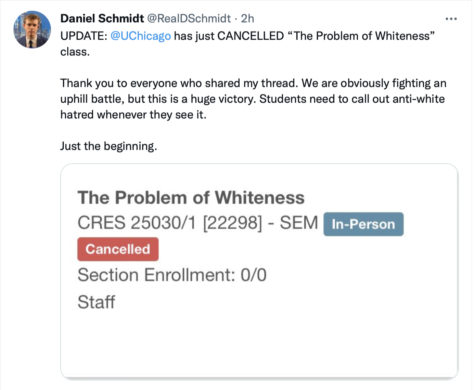
Contrary to the student’s proclaimed “victory,” my class was not in fact cancelled. I made the call to move it to spring quarter precisely because of his cyber harassment campaign, which placed a target on my body and therefore on my classroom.
In this discussion I want to pull focus on where it belongs: on the torrent of abuse this harassment campaign has incited. I won’t spend time here characterizing the 146 and counting taunts and threats to my body, safety, and psyche that have flooded my inbox since November 2. Read some of them for yourself in select screenshots published here. I want to ask instead how an institution avowedly committed to free expression has come to condone its weaponization. So let me begin with a thought experiment.
Had the student reached out to me with concerns about my course, The Problem of Whiteness, I would have happily scheduled office hours to discuss them. During that meeting, I would have listened to his concerns and addressed them by elaborating far beyond the five sentences published in the course catalog. I would have clarified that the class is not about “anti-white hatred” or my personal “problem with white people.” Both of those statements are value judgments; judgements which get in the way of critical inquiry. I would have explained that critical inquiry involves the rigorous study of social problems—problems which exert a shaping force on history and society. Grappling with such problems and the questions that flow from them—even and especially sticky ones, like race—is essential to the pedagogical enterprise.
I would have then walked the student, as I would any student, through what decades of careful scholarship on race and racism in the U.S. have taught us: whiteness, like any racial identity, has no basis in biology. It is a scientific and cultural fiction; a “pigment of the imagination,” if you like. It is, however, as historian George Lipsitz writes, a social fact “created and continued with all-too-real consequences for the distribution of wealth, prestige, and opportunity.” As an unmarked norm against which difference is constructed, “whiteness is everywhere in U.S. culture,” Lipsitz observes, “but it is very hard to see.” The act of marking whiteness, then, is to locate it as a specific historical and ideological formation, and to ask what it does in the world. That’s the mission of the class.
During this notional discussion, I would have let the student know that there is a long scholarly literature on whiteness which he might find fascinating. As a primer, I would have steered him to the Peabody Award-nominated series Seeing White, a podcast produced by the Center for Documentary Studies at Duke University, which I use as a teaching tool in my class. Then I would have introduced him to the wide-ranging literature, from the foundational works of W.E.B. Du Bois, Nella Larsen, and James Baldwin, to whom my course title pays tribute, as well as to the contemporary scholarship of Sara Ahmed, bell hooks, and Shannon Sullivan. I would have urged the student to approach these texts with a generous eye, to reflect on his own sense of grievance and victimization, and to consider other habits of mind, like intellectual curiosity and charity. I would have invited him to cultivate those habits in the seminar. I would have encouraged him to bring his ideas to the table, and to be open to the seminar as a space of spirited deliberation. In short, I would have done my job.
But this conversation never happened, because this student never reached out. He didn’t ask questions about my course description or request a copy of the syllabus. There was no thoughtful exchange of ideas during office hours. Clearly, this student is not interested in learning. As evidenced by his expertly packaged Twitter feed, he is interested in generating content for his MAGA media persona. In his bio, he positions himself as an amateur investigative reporter “exposing insanity” at the University of Chicago. White grievance—the notion that the true victims of institutionalized racism in the U.S. are white people—seems to be his main beat.
All of this leads me to conclude that this student has not been acting in good faith; that is, as a pupil expressing sincere concerns about a course offering. Rather, he has acted as a cynical opportunist chasing likes and shares. For this reason, I will refer to him as such in the remainder of this essay.
Because teaching fellows are junior scholars, we are institutionally precarious. To what extent this young opportunist understood this and saw me as an easy mark is for the reader to assess. What is knowable are the consequences of his actions (thus far).
When the opportunist found my course description in the winter term schedule, he seized a chance to go viral on social media by stoking racial resentment. In the “EXCLUSIVE” Twitter thread in which he deputized an indignant mob to attack me via email, he crafted just enough plausible deniability to dodge a lawsuit. Yet his followers clearly understood what they were being invited to do (harass a professor). As their emails and comments below show, they also understood the subtext of racial grievance in play:
“Thank you for sharing *****@uchicago.edu’s contact information. Peeps, you know what to do. Now get to it.”
“Just sent her an email…Suggest others do the same.”
“Keep going. Journey needs to be fired.”
“You should sign up and livestream it.”
“Yes. Put this across the internet.”
“Rebecca Journey is among the most dishonest, disgusting, degenerate, and deeply evil figures in public life.”
“People like Rebecca are rotten inside and that shows with the ugly outside.”
“Hell I got sick of people who look like her talk about ‘gender’ in like 1997.”
“Is she white or an actual ghost? Why are these people always pasty, rail thin white women? How many cats does she have?”
“She ain’t white. She’s fucking translucent.”
“She’s a ginger, they don’t have souls.”
“She’s Jewish though, right?”
“I’m guessing the teacher is a J.”
“Physiognomy never lies.”
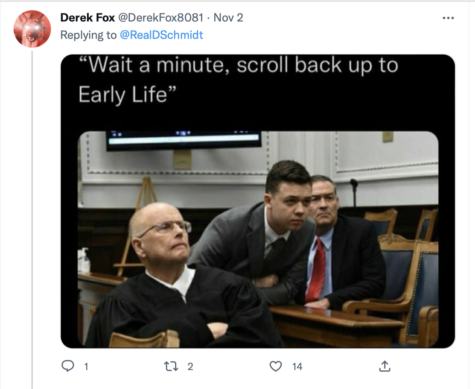
This is not trolling. It is not cancellation. This is abuse. The opportunist did not simply “call [me] out.” He preyed on a private figure—a precariously employed postdoc—to further his own craven ambitions. He weaponized his free speech to stifle mine.
Reactionary attacks on academics are not new. What’s new about the practice in the 21st century is the force multiplier of social media. I am not even on Twitter, and yet I was targeted and terrorized through it. In just 280 characters or fewer, a user can mobilize a collective, decentralized attack and walk away, feigning ignorance. Righteousness, even. I was just “calling out” “anti-white racism.” Let the dregs of the internet do the work.
Putting aside for a moment the logical incoherence of this tactic (free speech for me; censorship for you), I want to focus on how it undermines the educational mission of the University.
The University of Chicago has long taken an absolutist stance on the principle of free expression. In the Report of the Committee on Freedom of Expression commissioned in 2014, the authors affirm the University’s “profound commitment” to supporting “the freedom of all members of the community ‘to discuss any problem that presents itself.’” However, they write:
The freedom to debate and discuss the merits of competing ideas does not, of course, mean that individuals may say whatever they wish, wherever they wish. The University may restrict expression that violates the law, that falsely defames a specific individual, that constitutes a genuine threat or harassment, that unjustifiably invades substantial privacy or confidentiality interests, or that is otherwise directly incompatible with the functioning of the University.
Does a torrent of hate speech on Twitter constitute a discussion? Is placing a target on an instructor’s body and classroom compatible with the function of the University? These are the dystopian affordances of social media. The College is not a closed system.
Offering no public comment apart from a “note on course offerings” briefly posted on the Global Studies homepage, the University responded to the incident two weeks later in an internally circulated set of two emails. The administration has taken the position that the opportunist’s targeted harassment campaign does not violate University policy on free expression. At the time of writing, he has faced no disciplinary consequences for his conduct. This, despite harassing a fellow student earlier this year.
The University’s belated, tepid response to this incident reduces its stakes to an abstract question of academic freedom. It sanitizes the white rage, misogyny, and antisemitism that hundreds of speakers routed through the opportunist’s provocation. There is more to say here about the interplay of each of these dynamics in the spectacular demolition of a female junior scholar. There is also more to say about the extent to which the far right has normalized violence in American life. But I want to stop here and ask: Why has the University shirked its “profound commitment” to protect the pedagogical project?
What this ugly incident reveals is just how hollow these commitments actually are, and just how little the administration has reckoned with the power of technology to thwart them. It exposes this language as naïve. What would it mean to affirm those commitments today, to borrow philosopher Wendy Brown’s (2017) phrase, in the “apocalyptically populist” present?
Is going viral by doxing and harassing an instructor—particularly a structurally vulnerable one—a viable path to a media career? That is the message being telegraphed to others watching this play out. Bad faith actors will learn that they can hide behind the cover of free expression as they defame scholars and compromise classrooms.
The University has permitted the opportunist to terrorize an instructor, her students, and I would also argue our campus. Let me spell out the nature of that terror if it is not already clear. A teacher is not free to do her job if she is fearful that an armed white nationalist, activated by a provocateur, will track her down and shoot up her classroom. This is not hyperbole. This is America in 2022.
Membership in the University community requires acceptance of its educational mission. This opportunist has rejected that mission. Indeed, his conduct has placed it in harm’s way.




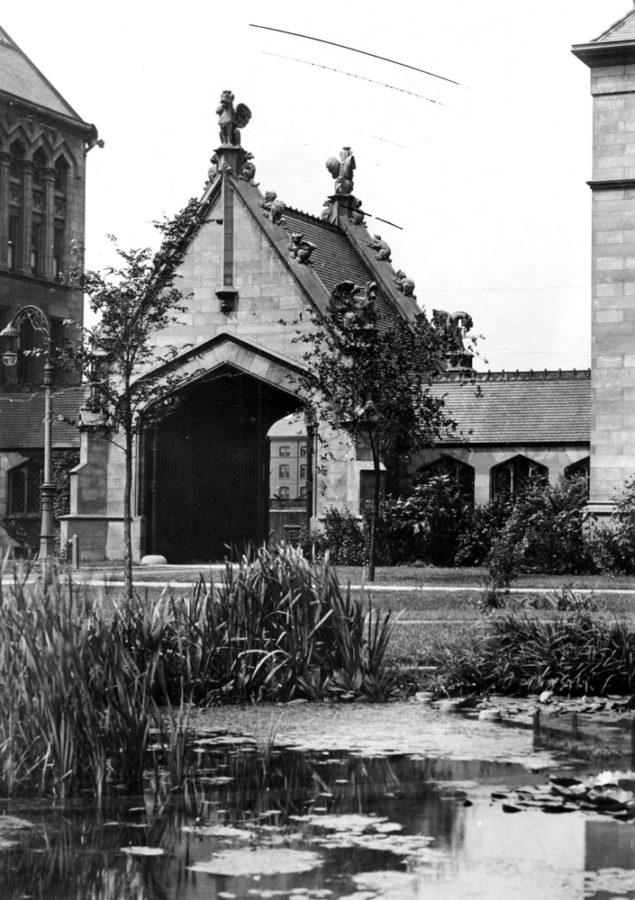




Melvin / Jul 12, 2023 at 12:55 pm
This should be called “The Chicago Moron”
Melvin / Jul 12, 2023 at 12:50 pm
A better title would be “racist teacher thinks white people are better than others and starts a class to prove it”
Paul / Jul 6, 2023 at 2:49 pm
Journey is obviously wrong here.
” Yet his followers clearly understood what they were being invited to do (harass a professor).” Does Journey have any proof of this intent, or is she simply assuming?
“The administration has taken the position that the opportunist’s targeted harassment campaign does not violate University policy on free expression.” Did Schmidt coordinate a “targeted harassment campaign” or is Journey embellishing? Because I see now evidence of that activity.
“There is also more to say about the extent to which the far right has normalized violence…” Ok, so now Schmidt is committing violence against Journey, or something?
“Is going viral by doxing…an instructor…” How was Journey doxxed? Her identity and email address is publicly available. That’s not doxxing.
“The University has permitted the opportunist to terrorize an instructor…” Terrorize? Really? How was Journey terrorized?
A teacher is not free to do her job if she is fearful that an armed white nationalist, activated by a provocateur, will track her down and shoot up her classroom. This is not hyperbole.” Not hyperbole? Journey just added violence which she presents no evidence of in her piece.
“…threats to my body, safety, and psyche that have flooded my inbox…” Again, where are the threats to her safety? I don’t see any in the screenshots she provided? I’m not saying that the people who contacted her are acting in a way I find appropriate or constructive, but Journey takes them and engages in the very dramatic hyperbole she claims to avoid.
Hysterical Woman / Jul 8, 2023 at 1:41 am
Try reading the evidence—that is, screenshots of violent and sexually harassing emails—that are published in the piece. There is a slideshow. You need to click on it.
You are obviously wrong here.
Paul / Jul 26, 2023 at 11:34 am
Where, which ones?
Hysterical Woman / Jul 8, 2023 at 2:46 am
“‘I’m not saying that the people [who threatened her life and body] are acting in a way I find appropriate or constructive,’ I’m just saying that those psychological harms and material threats are an abstraction for me.”
Paul / Jul 26, 2023 at 11:36 am
Which psychological harms? How is that quantified in a non-legal environment. Do you mean someone says “I was psychologically harmed” and everyone must say “yup, you sure were.” That’s absurd. And which material threats?
Lola / Jul 3, 2023 at 8:53 am
This “young student” is following a well-established model of far right provocateurs in the likes of Bannon et. al.. Schmidt isn’t hurt or threatened. He is busily angaging his personal base to get attention, make a lot of money, run for some office somewhere and eventually wind up trampling the rights and feelings of anyone he doesn’t like.
This power of small voices is a nasty dangerous threat to all of us.
Paul / Jul 6, 2023 at 2:51 pm
A “dangerous threat” how exactly? And how is Schmidt making a lot of money? Whose rights is he trampling?
Hysterical Woman / Jul 8, 2023 at 2:36 am
Schmidt is dangerous because he is a disingenuous, careerist provocateur who weaponized social media to stifle the speech of an untenured female professor.
Your question,”Whose rights is he trampling?” betrays your incapacity to grasp that women have a right to speech as well as a right to enjoy a workplace free from threats of violence and sexual assault from anonymous ghouls. What Schmidt did is cyberstalking by proxy: he enlisted a cyber mob to harass a female professor on his behalf, over and over and over again. This, sir, would be an example of what we call misogyny.
Schmidt is trampling the rights of Dr. Journey to teach her class without a target on her back. Read up on the Waterloo attack.
Pro tip #1: a veiled threat is still a threat. Allusions to murder and rape are threats. Period.
Pro tip #2: mob violence is one tactic white supremacists used to maintain the Jim Crow social order in the late 19th/early 20th centuries. Cyber mobbing is a 21st century update.
Paul / Jul 26, 2023 at 11:38 am
“Cyberstalking by proxy.” Again, how so? You simply assert things but provide no objective evidence of your claims. “I feel ___” is not evidence.
“Allusions to murder and rape are threats.” Where are these threats of murder and rape made?
Melvin / Jul 12, 2023 at 12:51 pm
“This power of small voices is a nasty dangerous threat to all of us.”
This is the stuff of Jim Crow (democrats) from after the Civil War on.
Brown / Jul 3, 2023 at 7:53 am
Ms. Journey needs some self reflection here. She has chosen a provocative title for her class, then she has to take the reactions it provokes. As a non-White person who has always voted Democrat, I feel the conflict is started by Ms. Journey.
Melvin / Jul 12, 2023 at 12:52 pm
Right. If you have a controversial class expect controversy.
Miss World / Jul 15, 2023 at 3:01 pm
You are unaware of the title’s genealogy as well as its double-meaning. If you’re not an academic, you wouldn’t get it, of course, because the course is not designed for Internet randos. It is designed for UChicago undergraduates who have encountered concepts like white privilege and race as a social construct.
Ignorant critiques of the course title illustrate precisely the hazards of extracting an academic debate from its context and setting it on fire on social media. Twitter doesn’t do nuance. Schmidt understands this very well. He is a grifter who wants to impose Internet norms into academic spaces so he can monetize the celebrity of becoming a viral culture warrior. This is dangerous. It puts teachers—and students—in harm’s way.
Let’s take a look at the victim-blaming logic of your hot take. What happens if we swap out a few words?
“She has chosen a provocative [dress] for her [body], then she has to take the [harassment and potential assault] it provokes.”
No woman—no human being—is EVER “asking for it.”
B. L. Thomas / Apr 24, 2023 at 5:35 pm
It’s too bad as Americans we can only
focus on race and gender. I like to imagine what our country would be like if we focused on civil discourse and unity. Our country would be a better place. Instead, I watch the hate WE ALL spew from our mouths with spittle dangling from the corners just waiting to be launched at the next fellow countryman. It’s sad how divided we are.
My Name / Mar 18, 2023 at 10:32 am
Brainwashing youth into racism is NOT “freedom of speech”, it is a crime!
Yang / Dec 23, 2022 at 6:36 pm
The comments on this article are equally as appalling as the harassment that Dr. Journey has received, and I am shocked to see some of you calling yourselves as alumni of UChicago. Have any you not taken a single social science course at UChicago?
It is so weird to see people so fixated on the name of the course and the supposed contents of said course, without understanding that the ‘problem’ in ‘problem of whiteness’ is referring to the precise complexity in understanding ‘whiteness’ as a historical and ideological construct, like most racial markers are. This doesn’t mean that racial markers are not real or are a ‘cultural fiction’, as one of you here is intentionally misreading. Nor does it mean that the category of ‘whiteness’ and how it has been constructed cannot be interrogated. There is a major difference between assuming a particular perspective on a social issue and taking a step back and tracing the different perspectives and ideologies around a social construct, and this course is trying to do the latter.
In fact, the way anthropological courses like this one work is PRECISELY to understand and press upon how ‘whiteness’ is understood, imagined, and embodied like the people here in this very comment section. Dr. Journey’s course isn’t even about offering one “right” view of looking at race! And for that matter, courses on the problem of “Blackness” and “Asian-ness” are actually taught in the university albeit under different course names. As an Asian, I also fully intend on teaching a similar class on the problem of Asian-ness in the future.
For those of you calling Dr. Journey “racist,” you are the ones who should be self-reflecting and actually consider taking such a course on “whiteness.” For all the hand-wringing about CRT and racial ideologies, y’all really do not know the first thing when it comes to studying a complex thing such as race. And it’s funny to see some of you reading into the course contents and imagine it to be an extension of Hollywood and media, when YOUR perspectives about race are fully informed by your own incendiary media consumption habits. I would love to see how any of you manage
Dr. Journey, please do not let a bunch of ignorant people scare you off from teaching an important subject. And if any of you detractors intend to walk your talk, UChicago welcomes critical inquiry and you are welcome to sit in the class, though I would think you would be hard-pressed to find a dissenting view because this course is NOT about presenting a “right” view of “white-ness”.
MadelineMardigan / May 15, 2024 at 11:20 am
How hard could it be, if you don’t like something, it’s racist, you’re not getting your way, racist. Class is too hard, Racist. See, it’s easy. I don’t think that CRT is what you pretend it is, because it’s really just an excuse to mentally and verbally abusing white kids and pretending that blaq crime is really racism. Black people should do more to better themselves instead of demanding the world change their lives and accept the violence and criminality from blacks. Time to start getting real. How many more things do we have to tolerate? We got idiots cheating their way thru ivy league schools, media covers up for black crime, corruption and mismanagement of cities run by blacks. Sick of the hypocrisy here. P.S. this “talk” you all say you have with your children about cop isn’t working.
Michael / Sep 21, 2024 at 11:23 pm
If a class was called “the problem of jews” or the problem of asians” or the “problems of blacks” you would not focus on nuance. Stop the BS. This class is racist garbage, pure and simple.
John / Dec 13, 2022 at 7:04 am
I actually feel sorry for you, Professor Journey. You know the implications of a course titled, “The Problem With Whiteness.” You should own that. Then, you should teach a course titled, “The Problem With Blackness.” You see how hateful and absurd that title feels? That’s how you should feel of your own course title.
I’m sorry you received such visceral messages in response; none of that was warranted. I think what is warranted is a personal reflection of your own biases. The internet has allowed you to exist in this bubble for quite some time. Maybe try to reach out to the student yourself, if you consider yourself the adult in the room.
Best wishes.
Jennifer / Dec 12, 2022 at 5:13 pm
A white person teaching about the “problem” of whiteness…farcical. She should give up her position to a much more deserving, by definition, POC. Problem solved.
Melvin / Jul 12, 2023 at 12:53 pm
You now caused her pain as she identifies as a POC – LOL
Matthew McGeehin / Dec 12, 2022 at 4:26 pm
You are more than just a racist. You are unprofessional. A teacher trying to wage a war on a student is simply poor professionalism. You deserve to be fired.
Patrick / Dec 12, 2022 at 4:17 am
A professor writing an attack piece about a student seems to be putting a target on the student’s back. Very unprofessional!
Ess / Dec 11, 2022 at 11:47 pm
I find it humorous that your preferred method of handling this situation would be to hand feed the kid your knowledge and he would have to lap it up because it is so right.
Is there a universe in which he could take your course, disagree with your truths being presented, and have you pass him without losing your mind?
“free speech for me; censorship for you” is your whole motto even if you say otherwise. Feels like you are forcing intellectual war until others agree with you.
M.R.F. / Dec 11, 2022 at 8:56 pm
Alumni, and very sorry the university allows a course to even carry a name like “The problem of…” anything referring to a subset of human characteristics. It’s only OK to the administration if it’s “whiteness”.
Now try “Asians” or “blackness” or “Pakistanis”.
You people are one long embarassment to this once fine university.
Able Wildcard / Dec 11, 2022 at 8:01 pm
Would she defend this premise for her Doctoral Dissertation? Would any refutation amount to violent provocation?
Joey / Dec 11, 2022 at 7:25 pm
Racism is bad, in all its forms.
Imagine a course named “The Problem of Blackness” or “The Problem of Jewishness”
The author is clearly an anti-white racist.
And as you can see, many white people have had just about enough of it.
JM / Dec 11, 2022 at 5:45 pm
Question: Would ANYONE be “okay” with a seminar called, “The Problem of Blackness?” If not, I think we have an insight into what’s going on here, throughout academia, and throughout Hollywood, the media, and politics.
Yes / Dec 11, 2022 at 4:41 pm
Friend, CRT is a divisive and wicked ideology. You have the freedom to teach it, but these comments are just that, comments. Mean people will always exist. If you teach an incendiary, racist class, you must be prepared for pushback.
Imagine a class called, The Problem of Blackness.
Steve / Dec 11, 2022 at 4:30 pm
According to Journey, whiteness is a cultural fiction. Logically extrapolated, blackness must be a cultural fiction, as would be any other pigmented group association.
Notan E. Moprog / Dec 11, 2022 at 1:33 pm
Learn to weld.
Michael / Dec 11, 2022 at 1:19 pm
So, this ‘faculty member’ is upset because a student called her out on the course she created and proposed to teach, and her response is to attack the student and attempt to defame/ridicule him because she got some mean emails? Defend the course, explain your position, but don’t attack students simply because they disagree with your position. Grow up.
Tony / Jul 4, 2023 at 10:20 am
Come on be real, what he did wasn’t just “disagree”, he attacked her first by cowardly using others to go after her instead of confronting her himself. And they weren’t just “mean emails”, as you try to demean them; most were more vicious and demeaning sexist, antisemitic slurs than her clear, explanation of what the “student” that you are attempting to defend actually did and consequently, is.
Ric / Dec 11, 2022 at 12:44 pm
She cries as she strikes you.
Pauline / Dec 9, 2022 at 8:40 am
I agree with Journey’s claim that the student ought to have come speak to her. At the same time, by focusing on the cyberbullying she, an adult, received, she fails to address the student’s actual concern. Moreover, this student is a young, male-seeming, adult and he is saying that he feels “hated.” Doesn’t that worry her? I think a lot of white students and professionals do feel despised in certain elite circles at the moment. Why deny this? This not mean that other people are not feeling despised too. This does not take away from social justice issues. And this young student’s feelings may be somewhat caused by so-called white fragility, but it also might be a reaction to what he is hearing around him, too. A lot of white professionals, imo, are aware of the history and continued oppression of POC, etc., and still, they feel, (and speak about only behind closed doors), the frustration they feel by the constant denigration of white people in (mostly) elite circles. All white people are not the same, obviously, nor are all white people ignorant of history and facts of racial injustice, yet, all white people are being asked to be treated the same way; as problematic, as ignorant, as a clueless mass. I don’t think there is anything wrong with Journey’s course, but I do think she handled this situation poorly. She is no better than the student, honestly, in how she handled this.
Liam / Dec 9, 2022 at 10:44 am
I’d call this comment “not in good faith”, but I feel like that would be a significant understatement. The “young student”‘s position as a provocateur overrides any possible “concern” you believe he may be earnestly expressing – reaching out to right-wing media with “EXCLUSIVE[s]”, concern trolling, and galvanizing a mob to harass a teaching fellow, yet she somehow has overstepped, “handled this situation poorly” by… writing an op-ed bringing these components of his methodology and ideology to light, and highlighting the 140+ abusive emails, peppered with antisemitic threats.
Here you are, concern trolling yourself with “so-called white fragility”, breathlessly stepping around reading any of the content of the article or the description of the course, instead preferring your own imagined contents of the course, your perception of it painting whiteness “as problematic, as ignorant, as a clueless mass”. You don’t engage with the actual content of /either/ position – instead, you’re claiming that both sides are just as bad as one another, because one is gleefully parroting neofascist talking points, and one is understandably upset with threats to their physical safety while teaching.
anonymous / Dec 9, 2022 at 1:15 am
Alumni and very genuinely sorry this happened to you. Wishing you nothing but the best moving forward from this.
Sarah Tuohey / Dec 8, 2022 at 6:14 pm
I too have been appalled by the university’s lack of response to the threats, insults, and harassment Ms. Journey has received. For a while my feeling has been that “The Chicago Principles” are a recruiting tool for the College rather than an expression of a commitment to freedom of expression. These “principles” were re-articulated (some five years back, I think) at a point where the voices of people of color, women, and queer people were still being hushed and fixed shut by the wide streak of conservatism (read reactionary) that runs through the College and the university as a whole.